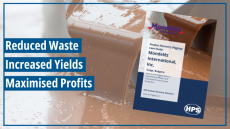Alternatives to heat processing viable say scientists
fields, radio-frequency electric fields, ultraviolet light, and
irradiation have been shown to be faster and less disruptive to
quality than traditional thermal processing techniques, say
researchers.
Food safety concerns and regulation have driven the food industry to explore different methods ofkilling harmful pathogens while maintaining quality. Heat sterilisation techniques are common.However heat can also lower quality.
Researchers at the US agriculture department are currently investigating several alternative non-thermal processingtechnologies, including high-pressure processing, pulsed electric fields, radio-frequency electric fields, ultraviolet light, and irradiation.
"Some of these nonthermal techniques were developed here, but we have also tested and improved other technologies developed elsewhere,"stated research leader Howard Zhang, who is part of a team investigating the technologies at theAgricultural Research Service (ARS). "Our work has improved food safety by enabling the food industry to make better decisions about how to reduce or eliminate foodborne pathogens."
High-pressure processing (HPP) treatment involves applying 80,000-130,000 pounds per square inch of pressure to a sample. Applying that extreme pressure fortwo to five minutes has been found effective in killing most vegetative microorganisms-those that grow in foods under normal storage conditions.
The researchers found that HPP treatment at 25°C can significantly reduce E. coli populations in tomato juice and liquid whole eggs. Their research also suggested that multiple brief high-pressure treatments were more effective than one lengthy treatment using continuous pressure for the same total amount of time.
While HPP can eliminate vegetative microorganisms, it is not effective at killing microbial spores. And atfive to ten cents per pound, it is too pricey to be practical, they foiund.
"We hope to develop pressure technology that is cheaper and more effective against spores,"stated Zhang.
The scientists also studied pulsed electric field and radio-frequency electric field treatments in studies of methods to pasteurize liquid foods such as apple cider without usingheat.
They claim to have improved uses pulsed electric fields (PEF) to kill yeasts, molds, and vegetative bacteria in liquid foods.Such intensive electric pulses break down the cell membranes of the microorganisms.
One of their studies looked at the feasibility of using PEF in making shelf-stable salad dressings.A model salad dressing for the study was formulated by Kraft Foods.
The Agricultural Research Service scientists inoculated the dressing with Lactobacillus plantarum, a very heat-resistant spoilage bacterium. The sample was then treated either by PEF alone or by PEF followed by mild heat. While PEF treatment alone significantly reduced L. plantarum, the dressing retained microbial shelf stability only when refrigerated. PEF plus mild heat exposure, however, produced shelf stability at roomtemperature, they found.
Another of their studies subjected applesauce samples to PEF followed by mild heat treatment. The processed applesauce was aseptically packed into plastic cups and stored at room temperature.
Their evaluations indicated that the processed applesauce maintained high sensory quality during 470 days of storage. That's a longer shelf life than is currently used in commercial practice.
"This research demonstrated that following PEF with mild heat may be used in producing high-quality, shelf-stable applesauceproducts," they stated.
They also studied radio-frequency electric field (RFEF) technology, which like the PEF process subjects liquid foods to high electric fields.This procedure-developed at the ARS-uses a continuous alternating current power supply, which costs less than a PEF pulse generator.
In one study, the scientists applied RFEF for three seconds at 60°C to an apple juice sample inoculated with E. coli. The electrical cost of RFEF processing was aboutone cent per deciliter (10.5 quarts), and the procedure was more effective than conventional heating under the same conditions.
Other studies investigated ultraviolet (UV) light and irradiation technologies as alternatives or complements to thermal processing.
Scientists used UV processing on an apple cider sample that had been inoculated with bacteria. Heat and chemical treatments can destroy bacteria within cider, but they generally alter the flavor.
The UV treatment reduced populations of E. coli and Listeria innocua by more than 99 percent without changing the liquid's flavor.The scientists believe UV processing has potential to improve the safety of apple cider and extend its shelf life without diminishing its quality.
They also investigated whether UV processing could provide safe liquid egg products. Extensive thermal pasteurization, though effective for other types of food, damages the functional properties of eggwhites.
The researchers combined UV and heat treatments to kill E. coli in liquid egg whites. Whites infected with E. coli O157:H7 were processed using a simple UV apparatus consisting of a low-pressure mercury lamp surrounded by a coil of UV-transparent tubing.
The scientists found that UV treatment at room temperature can significantly reduce the heat subsequently required to pasteurize liquid egg whites.
Irradiation exposes food to a low level of ionizing radiation to kill bacteria, molds, yeasts, parasites, and other microorganisms that can lead to food spoilage and illness if untreated.
Over the last 25 years, studies have shown that eating irradiated foods poses no increased health risks for consumers.The ARS studies have enabled federal regulatory agencies to establish standards to ensure safety and quality of irradiated products like fruit, vegetables, juice, meat, and meat substitutes.
At three to five cents per pound, irradiation is slightly more expensive than thermal processing, but its success in deactivating spores and other microorganisms has made it an option for the food industry.








